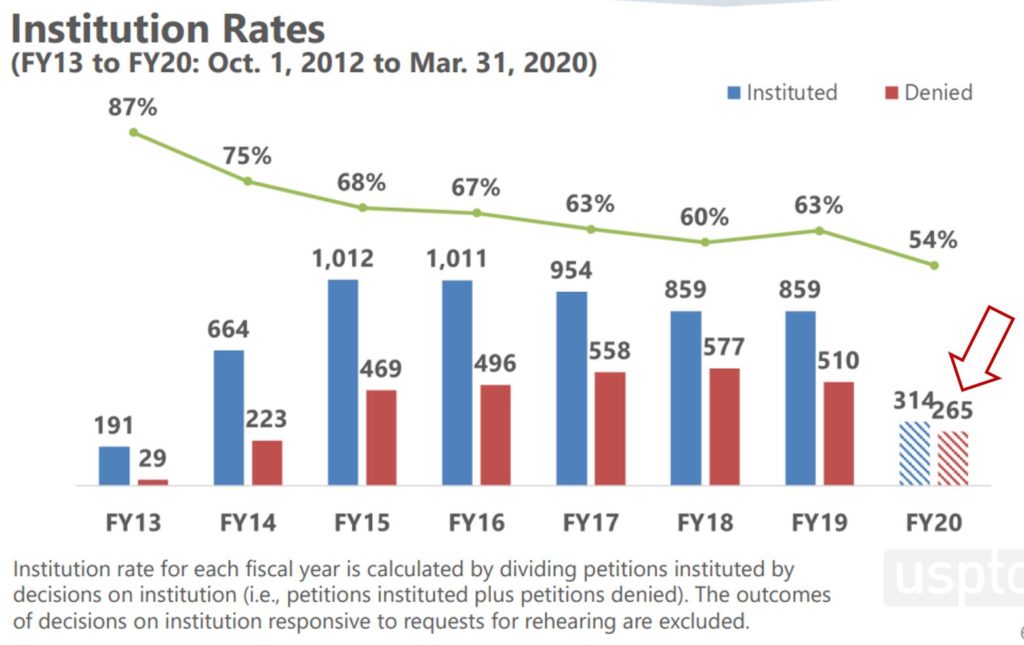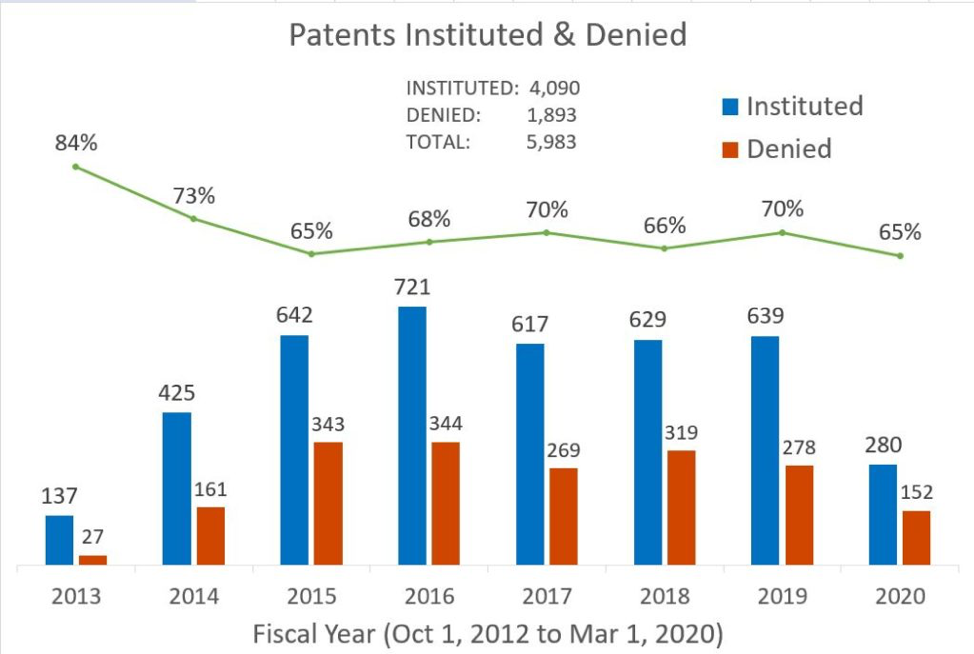“USPTO official reporting of PTAB institution rates fails to account for the effect of multiple petitions filed against the same patent. Stakeholders and policymakers would be better informed to consider the institution rate based on patents.”
 Despite rumors that changes have been made at the USPTO to bring balance to the Patent Trial and Appeal Board, a hard look at the data shows that it is business as usual. Astounding numbers of patents continue to be invalidated despite many superficial changes over the past few of years.
Despite rumors that changes have been made at the USPTO to bring balance to the Patent Trial and Appeal Board, a hard look at the data shows that it is business as usual. Astounding numbers of patents continue to be invalidated despite many superficial changes over the past few of years.
- Inventors were heartened and hopeful when President Trump appointed Andrei Iancu to replace Google attorney Michelle Lee as the Director of the USPTO on August 25, 2017.
- The most significant change to PTAB practice in 8 years has been the change of the claim construction standard from the Broadest Reasonable Interpretation (BRI) to the Phillips standard, which went into effect for petitions filed on or after November 13, 2018.
- The AIA Trial Practice Guide was updated in August of 2018 and again in July of 2019 to provide “guidance” on whether to institute trials with respect to multiple petitions, previously considered issues, parallel district court proceedings, and other factors under §314(a), §316(b), and §325(d).
- Several decisions have been designated precedential with respect to discretionary denial of institution, such as General Plastics (September 6, 2017) and NHK Spring (September 12, 2018).
- The USPTO Standard Operating Procedures SOP-1 and SOP-2 were updated on September 20, 2018 to govern assignment of APJs, expanded panels, and designation of opinions as informative or precedential.
- Scott Boalick was appointed to replace David Ruschke as Chief Administrative Patent Judge on March 13, 2019.
Several hundred institution decisions have been issued under these changes, establishing a statistically significant sample size for evaluation. Detailed analysis of the data proves that nothing has changed at the PTAB which continues to permit abuse and invalidate an astoundingly high percentage of patents. The “death squad for patents” is as lethal as ever.
Background
The 2011 America Invents Act established the Patent Trial and Appeal Board (PTAB) as a division within the USPTO to conduct trials challenging the validity of previously issued patents.
Since 2011, there have been almost 10,000 proceedings affecting almost 7,000 patents. One important subject of analysis is the Institution Rate. This is the preliminary decision where if the PTAB decides that a patent is suspected to be defective, a trial is ordered. It is similar to an indictment in a criminal proceeding.
The USPTO reports the institution rates, but their analysis is based on petitions, rather than patents. Since many patents are challenged multiple times (in one case a patent was challenged 23 times), it is helpful to understand the net patent invalidation rate.
NOTE: The author acknowledges and applauds the USPTO for addressing this concern at the recent Patent Public Advisory Committee meeting. That is a good start. At the time of publication the official report is still (misleadingly) based on petitions.
 The USPTO reports that 314 petitions were granted and 265 petitions were denied so far in FY2020, resulting in a 54% institution rate. However 62 of the 265 petitions that were denied had one or more sibling petitions against the same patent which were granted. Those 62 petitions were members of successful family of petitions against the targeted patents, thus should not be counted as favorable to the inventor.
The USPTO reports that 314 petitions were granted and 265 petitions were denied so far in FY2020, resulting in a 54% institution rate. However 62 of the 265 petitions that were denied had one or more sibling petitions against the same patent which were granted. Those 62 petitions were members of successful family of petitions against the targeted patents, thus should not be counted as favorable to the inventor.
Patent Institution Rates
Institution is a critical threshold for inventors. Once instituted, a patent is stripped of the presumption of validity and the procedures heavily favor invalidation. Previous reports have shown that the PTAB invalidates 84% of patents (in part or whole) that reach a final decision. This analysis covers 5,983 patents for which the PTAB has issued an Institution Decision.
Data is obtained directly from the USPTO via the PTAB v2 API.
As can be seen from the graphic above institution rate per patent is 65% to 70%. This rate is significantly higher than the rate reported by the USPTO. Also, the trend here is flat. The same percentage of patents are being instituted from 2015-2020. The USPTO data is misleading to the extent it shows a downward trend from 2015-2020.
The discrepancy is due the USPTO permitting multiple petitions per patent as noted above. Exploring the institution rate as a function of the number of petitions per patent is informative. All date headings in this report reflect the USPTO Fiscal Year which begins Oct 1 of the preceding calendar year. The data for 2020 covers Oct 1, 2019 to March 31, 2020 which is half of the year.
Multiple Petitions Effect on Institution Probability
The table above shows percentage of patents that have been instituted as a function of the number of petitions against each of those patents.
The number of petitions strongly correlates with the probability of institution. As can be seen, the probability of institution increases from 63% with a single petition to over 90% for 6 or more petitions.
In light of the rhetoric going around that the PTAB has been balanced, it is a little surprising that filing multiple petitions remains extremely effective through 2020. One might expect extra petitions are being denied more frequently on discretionary grounds. On the other hand, perhaps it should not be surprising that extra shots fired means extra fatalities.
As will be seen below, crafty challengers are taking advantage of this correlation without repercussions.
Frequency of Multiple Petitions
The tables above show the volume and distribution of the 9,685 petitions that have been filed as a function of their family size (family meaning the group of petitions filed against the same patent).
A minority of petitions are filed as a sole petition against a patent. The other petitions are filed as one member of a family against the same patent. The USPTO has reportedly promulgated rules and opinions designed to discourage multiple petitions. But filing multiple petitions works! So it is not truly discouraged.
Serial vs. Parallel Petitions
For the USPTO to entertain an single petition to invalidate a previously approved patent is bad. Entertaining multiple petitions is worse. The most sinister of all multiple petitions is the serial petition, one that is filed months later when the inventor has exposed his defensive strategy in a prior petition. A serial petition for this study is defined as a petition filed more than 90 days after a prior petition. A parallel petition is defined as a petition filed less than 90 days after a prior petition, however in most cases they are filed on the same day as the prior one.

The table above shows the break down of the family types of the 9,685 petitions that have been filed – single, parallel, and serial. Multiple petitions are roughly balanced between parallel and serial. There does appear to be a shift starting in 2019 where serial petitions flipped from a slight majority to a slight minority of multiple petitions.

The table above shows percentage of patents that have been instituted based on whether they were attacked by a single petition, parallel petitions, or serial petitions. I have faced down just about every indignity and abuse concocted by the most vicious infringers and lawyers in the industry. There are two that I have not yet had to face – accusation of claiming ineligible subject matter under §101 and a serial petition at the PTAB. These lethal serial petitions prevail at institution of trial in 85% of the patents they target!
Specific Examples
Drilling down sheds more light on what transpires in the proceedings underlying these statistics.

Among the proceedings in FY 2020 there are several patents that have been attacked by a family of 6 or more petitions, and trials were instituted on 100% of those patents. The underlying data follows.

As revealed by the table above, 70 petitions were filed against 9 different patents in this 6+ petitions category for FY 2020. 4 patents received 6 petitions each, 3 patents received 7 petitions each , one patent received 10 petitions, and one 15 petitions (!). Note that these patents are included in the data for FY2020 because that is the period for which the most recent decision was rendered. Also shown in this table is the date of the first decision in the petition family. If the first decision data precedes the last decision date by 90 days or more, it is a serial petition.
4 patents were subject to parallel petitions and 5 were subject to serial petitions.
Importantly, it can be seen that not all the petitions were instituted, yet all the patents were instituted. The institution rate on a petition basis is 64%. However, the true patent institution rate is 100%.
Drilling down further we can see what transpired for the recently issued patent US 10,186,523. This is a patent on a valuable invention from 2006 that enables high density and low power semiconductor chips.

Several observations can be made here:
- The patent was challenged 6 times by the same entity (Intel Corporation)
- These were parallel petitions
- The basis of each petition was obviousness under §103
- Claim 1 was challenged 6 times
- Claim 2 was challenged 4 times
- 3 of 6 petitions were instituted (granted)
- Every challenged claim was denied
- Every challenged claim was instituted
The USPTO report considers this a 50% institution rate. Our reporting counts this as 100% institution rate.
Conclusion
USPTO official reporting of PTAB institution rates fails to account for the effect of multiple petitions filed against the same patent. Stakeholders and policymakers would be better informed to consider the institution rate based on patents. While both approaches indicate extremely high institution rates (over 50%), the rate is substantially higher when the effects of multiple petitions are considered.
As can be seen in the charts and tables above, there is no significant change in the occurrence of repeat petitions or in the patent institution rate from 2014 to 2020. Any policy changes at the USPTO appear to have had no effect. Institution rates remain extremely high at 65%-70% of challenged patents consistently being instituted for trial.
Under these circumstance, inventors have no rationale basis to pursue patenting in the United States. Significant improvements are required in order for patents to once again become an incentive for innovation.
Image Source: Deposit Photos
Image ID: 91318112
Author: Rawpixel

![[IPWatchdog Logo]](https://ipwatchdog.com/wp-content/themes/IPWatchdog%20-%202023/assets/images/temp/logo-small@2x.png)





![[Advertisement]](https://ipwatchdog.com/wp-content/uploads/2024/04/Patent-Litigation-Masters-2024-sidebar-early-bird-ends-Apr-21-last-chance-700x500-1.jpg)

![[Advertisement]](https://ipwatchdog.com/wp-content/uploads/2021/12/WEBINAR-336-x-280-px.png)
![[Advertisement]](https://ipwatchdog.com/wp-content/uploads/2021/12/2021-Patent-Practice-on-Demand-recorded-Feb-2021-336-x-280.jpg)
![[Advertisement]](https://ipwatchdog.com/wp-content/uploads/2021/12/Ad-4-The-Invent-Patent-System™.png)







Join the Discussion
13 comments so far.
shawn ambwani
May 31, 2020 04:59 pmThanks for clarifying. That is useful, then it should be labeled on a per patent basis rather than family as I think that is confusing. The next 2 items of concern are that the study doesn’t take into account the claims in a patent. 2 petitions may be against the same patent but on completely different claims. So the actual arguments are not overlapping but simply because of page limits require a petitioner to file multiple ones. Second, it doesn’t take into account the amount of litigation using a patent. It should not be a surprise and pejorative that if a patent owner sues many entities, that those entities will file separate challenges, especially because of recent 314 and 325 discretionary decisions.
A better study would look at number of times the same claim were challenged by the same party.
CharlieSeattle
May 26, 2020 08:32 pmEliminate the PTAB office at once!
Josh Malone
May 22, 2020 04:30 pm“Family” here refers to the set of petitions filed against a single patent. It has nothing to do with patent families.
Shawn Ambwani
May 22, 2020 02:14 pmThe whole study has a fundamental flaw as far as I can tell. If there is a lawsuit with 2 patents from the same family and both are challenged (even by different entities), it counts that as multiple petitions. The reason why a lawsuit has multiple patents from the same family is typically because there are multiple reads of infringement which might be occurring. The study should look at multiple filings on the same patent (and then by entity), not the entire family. If that was done the numbers are simply not that high. You can look at all the filings on our portal for free and even the multiple ones.
portal.unifiedpatents.com
Jeff Hardin
May 22, 2020 01:26 pmI’ll also add that this data shows exactly who the “patent trolls” are in 2020. Our current PTAB system goes directly against the AIA’s Sense of Congress: “the patent system should promote industries to continue to develop new technologies that spur growth and create jobs across the country which includes PROTECTING THE RIGHTS OF SMALL BUSINESSES AND INVENTORS FROM PREDATORY BEHAVIOR that could result in the cutting off of innovation.”
This predatory behavior against small businesses and inventors at the PTAB must be stopped.
Jeff Hardin
May 22, 2020 12:29 pmRandy @ 5.
Also,
Article III Court = legal contingency representation for the inventor.
PTAB = No contingency and a $450K bill to the inventor for each PTAB attempt.
Is the PTAB a fair alternative to District Court? Not in the least.
David Lewis
May 22, 2020 12:39 amAs congress told the director that he has been given broad authority, perhaps rules can be written making the institution, based on a second petition, very unlikely. Particularly, it the petition is filed by the same entity?
fedsm
May 21, 2020 08:46 pmRandy – it’s a bit of that, the recursive improvements with repeated attempts at the PTAB, and also a bit of gambling, in that, eventually you’ll draw the right set of judges. All it takes is one win.
Randy Landreneau
May 21, 2020 05:25 pmArticle III Court = one bite at the apple.
PTAB = Use teams of attorneys to study each failed PTAB attempt and adapt like the Borg until the technology can be assimilated.
I thought the PTAB was supposed to be a fair alternative to District Court.
NewLawschoolGrad
May 21, 2020 02:24 pmJonathan@2 – what about Josh’s analysis is proved/dis-proved based on the whether the patents in question involve “high-stakes” litigation?
It appears that the higher the value of the patent (based on potential damages/royalties), the more a defendant (or their privy) would be willing to spend on filing as many IPR petitions as are necessary to get the PTAB to institute at least one.
Josh’s data indicates that this approach is, currently, close to fail-safe.
Anon
May 21, 2020 01:13 pmAn interesting article — and an elephant in the room (given that Mr. Stroud has already posted): this article is the ‘anti-spin’ to the recent (attempted?) spin BY Unified Patents that the AIA’s post grant review mechanism is NO LONGER ‘that bad.’
Gentlemen, you both can not be correct.
Jonathan Stroud
May 21, 2020 11:45 amI’m going to go out on a limb and, without looking, guess that the 6+ petitions category were filed either in 1) high-stakes semiconductor cases or 2) the high-stakes Comcast v. Rovi. Is that right?
Russell Slifer
May 21, 2020 10:10 amJosh,
Assuming no statutory changes are coming from Congress, what would you suggest the USPTO change (besides the reporting) to address this issue? Deny all multiple petitions? From the same petitioner only?
Russ